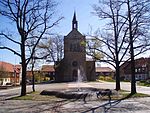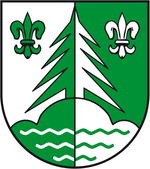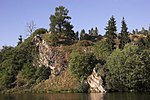Hassel Auxiliary Dam

The Hassel Auxiliary Dam or Hassel Dam (German: Hasselvorsperre or Vorsperre Hassel) is an auxiliary dam or pre-dam on the Rappbode Reservoir in the Harz mountains of central Germany. It is located near Hasselfelde in the state of Saxony-Anhalt and impounds the waters of the Hassel, the eastern of the two headwaters of the Rappbode Reservoir. Together with its auxiliary dams, the reservoir supplies drinking water and is owned by the Saxony-Anhalt Dam Company (Talsperrenbetrieb Sachsen-Anhalt). The purpose of the auxiliary dam is to pre-clean water mechanically and biologically before it flows into the main reservoir. Water can be collected from various heights and diverted to the reservoir. The barrier itself is a 21 m high gravity dam. The bedrock consists mostly of grauwacke, but with some thinly laminated argillaceous shale as well. There is a circular path around the Hassel Auxiliary Dam. The crest of the dam is accessible to pedestrians and the lake may be fished provided permission is obtained. The Hassel Auxiliary Dam is checkpoint no. 53 in the Harzer Wandernadel hiking trail network.
Excerpt from the Wikipedia article Hassel Auxiliary Dam (License: CC BY-SA 3.0, Authors, Images).Hassel Auxiliary Dam
Hassel-Vorsperre, Oberharz am Brocken
Geographical coordinates (GPS) Address Nearby Places Show on map
Geographical coordinates (GPS)
| Latitude | Longitude |
|---|---|
| N 51.7061 ° | E 10.8303 ° |
Address
Hassel-Vorsperre
38899 Oberharz am Brocken, Hasselfelde
Saxony-Anhalt, Germany
Open on Google Maps






